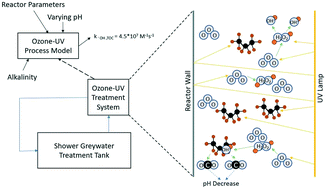Mineralization of greywater organics by the ozone-UV advanced oxidation process: kinetic modeling and efficiency
Abstract
Ozone-UV advanced oxidation treatment can mineralize total organic carbon (TOC) in water without the addition of chemicals, representing an alternative to phase-transfer processes such as reverse osmosis for water reuse. However, efficiency is governed by competing principal reaction pathways, and limited information has been available for optimizing treatments in such applications. In this study, a 1.2 m3 per day (320 GPD) pilot ozone-UV greywater reuse system was tested using simulated and real shower water, and the resulting kinetic data were used to develop a kinetic model of TOC mineralization. H2O2 is produced by photolysis with ozone, and subsequent reactions produce hydroxyl radicals, which mineralize TOC. TOC mineralization efficiency is governed by TOC concentration (controlling transmissivity), pH throughout the treatment, ozone-UV dose ratio, and the evolution of pH due to CO2 production from TOC, which impacts oxidative efficiency dynamically. Modeled hydroxyl radical concentrations were ∼10−10 M, as expected during water treatment and reuse, and the second order rate constant for the reaction of hydroxyl radicals with TOC was [1.7–7.6] × 107 M−1 s−1, similar to others reported for the mineralization of wastewater organics. The minimum electrical energy for commercial UV and ozone equipment was assessed at 3.73 kW h per order per m3 of TOC mineralization, and modeling indicated a wide range of optimal dosing ratios. Treatment efficiency was found to depend strongly on a reactor design that ensures an influent TOC concentration low enough to allow the effective transmission of UV radiation. Further development of the kinetic model to account dynamically for pH evolution as a function of TOC mineralization, reactor hydraulics, and mixing is recommended.



 Please wait while we load your content...
Please wait while we load your content...
